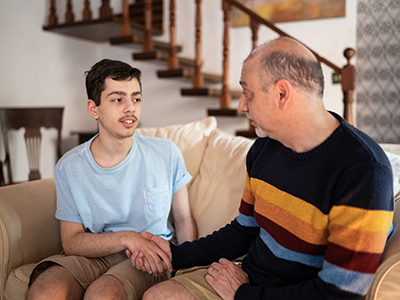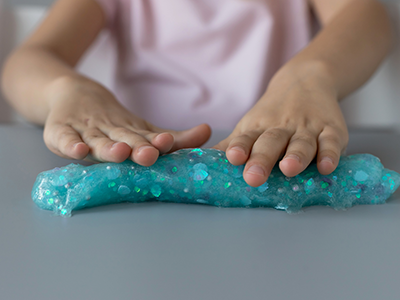When I was growing up, my parents always said that there was nothing harder for them than watching my siblings or me struggle, and often trying to figure out what to say to help us feel better. As an incredibly anxious child, there were many nights when I just could not sleep. My mom and I developed our own coping routine where we would curl up on the couch and watch old sitcoms late into the night until I eventually drifted off. One question I often hear from parents when their non or partially-speaking child who is struggling with things like anxiety, frustration and sadness is how to reach them, talk to them and help them. It can feel like an impossible task to teach a child coping skills when you cannot communicate with them in the way you feel you can communicate best. Take heart from my mom’s and my (completely wordless) coping routine — many of the things you can guide your child to do to calm down do not require any words at all!
Incorporate things that are fun but also soothing
There are a lot of great toys out there that will naturally guide children toward doing things that will calm their bodies. Some suggestions I use with my patients are:
- Pinwheels for deep breathing: Deep breathing calms the nervous system, but for a partially speaking child whose skills in imitation are still developing, it can be challenging to teach them to do this. Pinwheels are a great way to motivate children to copy a deep breath because there is an immediate reward of the pinwheel spinning.
- Picky pumice: Many nervous kids will pick and pull at things to keep their fingers busy, but this can be hard on skin, hair and clothes! These picky pumice stones are a way for kids to access this if they have naturally found picking as a coping skill, without shredding their wardrobe or fingernails.
- Playdough, thera-putty and squishy toys: One of the best ways to learn to regulate emotion is to begin noticing when our muscles are tense and when they are relaxed. This can take some practice as it is not something everyone pays attention to, but it can be even harder for non or partially speaking kids. When your child plays with a toy that allows them to squeeze and tense their muscles, it gives them a chance to notice the difference between tight and relaxed muscles and can promote muscle relaxation.
Use temperature and water to help your child calm their nervous system
- Ice: Gently applying ice to your child’s pulse points (wrists and neck) can help cool their body and slow their heart rate.
- Human “Dive Response”: Humans have this cool thing where when we are submerged in water that covers our ears, our body thinks we are diving and slows our heart rate redirecting more blood flow to our hearts and lungs. This can calm the nervous system and dull an intense feeling very effectively. If your child is struggling, a bath or a trip to the pool could help them calm down, or even submerge their face and ears in cool water for a few moments. You can demonstrate this by doing it first and blowing bubbles to engage their attention! NOTE: Always make sure your child is indicating they are comfortable being underwater/actively approaching water on their own before trying these skills. A surprise dunk or being forced underwater for a child who is not comfortable being submerged will make emotion dysregulation much worse and could be traumatizing.
Use sensory soothing
Pay attention to what your child gravitates to when they are left to their own devices. What sensations do they seek out? Put together a corner in their room or a family area with some of your child’s favorite sensory experiences. Examples could include:
- A lavender-scented beanbag
- A soft or silk blanket
- A device with their favorite music or children’s musical instruments
It can be heartbreaking to watch your child struggle with an overwhelming emotion. We hope these strategies help you feel like you have a few more tools at your disposal to help your child cope and reengage with their day. And remember, even when you feel helpless, you never know what is going to stick, work or stay with your child well into their adult years. When I think back to watching Full House in the middle of the night with my mom, I remember the sound of the theme song, the feeling of my mom’s shoulder under my head, the smell of my shampoo when my mom moved a piece of hair out of my face — knowing what to say, as it turned out, wasn’t very important in those moments after all.
 https://riseandshine.childrensnational.org/wp-content/uploads/2025/10/autism-image-feature.jpg
300
400
Rise and Shine
https://riseandshine.childrensnational.org/wp-content/uploads/2017/11/childrens_riseandshine_logo.jpg
Rise and Shine2025-10-28 15:41:562025-10-28 15:44:24Understanding autism beyond the headlines
https://riseandshine.childrensnational.org/wp-content/uploads/2025/10/autism-image-feature.jpg
300
400
Rise and Shine
https://riseandshine.childrensnational.org/wp-content/uploads/2017/11/childrens_riseandshine_logo.jpg
Rise and Shine2025-10-28 15:41:562025-10-28 15:44:24Understanding autism beyond the headlines





















Leave a Comment
Want to join the discussion?Feel free to contribute!